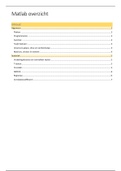Resume
MATLAB samenvatting commando's Statistiek & wiskundige data-analyse OPEN BOEK
- Cours
- Statistiek (E702090)
- Établissement
- Universiteit Gent (UGent)
Compacte maar zeer nuttige samenvatting van de taal Matlab. Met de focus op wat nuttig is voor het openboek-examen van Statistiek en wiskundige data-analyse, 2de bach industrieel ingenieur campus schoonmeersen. Maar volgens mij ook voor andere richtingen zeer bruikbaar, aangezien het over Matlab in...
[Montrer plus]



